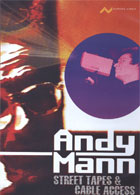
Andy Mann: Street Tapes & Cable Access 2010
Distributed by Microcinema International/Microcinema DVD, 1636 Bush St., Suite #2, SF, CA 94109; 415-447-9750
Producer n/a
Directed by Andy Mann
DVD, color, 70 min.
College - Adult
Art, Film Studies, Media Studies, Photography, Technology, Popular Culture
Date Entered: 01/19/2011
Reviewed by Linda Frederiksen, Washington State University VancouverIn 1968, the portable video camera was a new and exciting piece of technology. One of the first artists in the United States to explore the medium of video art was New Yorker Andy Mann. For the next forty years until his death in 2001, Mann created hundreds of videotapes on a wide range of social and popular culture topics. The 13 brief films in this compilation display the range of his work, while also preserving elements of his characteristic and pioneering style.
In Street Tapes, eight of Mann’s videotapes created throughout the 1970s are presented, beginning with Video Diary #1. Other titles in this section include One-Eyed Bum, Subway Tape, St. Anthony of Padua, There’s Going to Be Another War, Brooklyn Botanical Gardens, Andy Gets a Haircut and a short for WGBH Boston titled All around Boston. Using frequently grainy black and white film, off-camera narration, unconventional angles and sound techniques, Mann captures the feeling of urban life during this time period while also using his hand-held camera to experiment with textures and shadows and motion.
Part Two of the collection titled Cable Access, features five pieces made in Houston, Texas, from 1989-1990. By this time, working in color, with more sophisticated but still experimental production and editing techniques, Mann’s short films are more personal and include several monologues (or diatribes) about cable television.
The films, like the equipment that originally produced them, are from another era. As examples of some of the first creative work using the medium of videotape, however, each is an engaging illustration of a specific time and artist. Recommended for film and media studies programs.